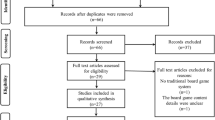Abstract
Challenging behaviors with multiple functions are often difficult to treat as function-based treatments may interfere with one another. Noncontingent reinforcement may be one efficient and effective means of treating multiply controlled behavior. The purposes of this study were to compare the use of noncontingent tangible reinforcement (NCT) to noncontingent escape (NCE) with two young children with autism who engaged in multiply controlled challenging behavior. Second, we wished to examine the effect of NCT and NCE on compliance during discrete trial training. A reversal design with an embedded alternating treatment design was used to compare NCT and NCE. The NCT treatment resulted in greater reductions of challenging behavior than the NCE treatment for both participants. Compliance during discrete trial training increased under both NCT and NCE treatments.



Similar content being viewed by others
References
Arick, J., Young, H., Falco, R., Loos, L., Krug, D., Gense, M., & Johnson, S. (2003). Designing an outcome study to monitor the progress of students with autism spectrum disorder. Focus on Autism and Other Developmental Disabilities, 18(2), 75–87. doi:10.1177/108835760301800201.
Beavers, G. A., & Iwata, B. A. (2011). Prevalence of multiply controlled problem behavior. Journal of Applied Behavior Analysis, 44, 593–597. doi:10.1901/jaba.2011.44-593.
Bondy, A. S., & Frost, L. (1994). The picture exchange communication system. Focus on Autistic Behavior, 9(3), 1–19. doi:10.1177/0145445501255004.
Carr, E. G., & Durand, V. M. (1985). Reducing behavior problems through functional communication training. Journal of Applied Behavior Analysis, 18, 111–126. doi:10.1901/jaba.1985.18-111.
Carr, J. E., Coriaty, S., Wilder, D. A., Gaunt, B. T., Dozier, C. L., Britton, L. N., & Reed, C. L. (2000). A review of “noncontingent” reinforcement as treatment for the aberrant behavior of individuals with developmental disabilities. Research in Developmental Disabilities, 21, 377–391. doi:10.1016/S0891-4222(00)00050-0.
Cook, C. R., Mayer, G. R., Wright, D. B., Kraemer, B., Wallace, M. D., Dart, E., Collins, T., & Restori, A. (2012). Exploring the link among behavior intervention plans, treatment integrity, and student outcomes under natural educational conditions. Journal of Special Education, 46, 3–16.
DeLeon, I. G., & Iwata, B. A. (1996). Evaluation of a multiple-stimulus presentation format for assessing reinforcer preferences. Journal of Applied Behavior Analysis, 29, 519–532.
DeLeon, I. G., Neidert, P. L., Anders, B. M., & Rodriguez-Catter, V. (2001). Choices between positive and negative reinforcement during treatment for escape-maintained behavior. Journal of Applied Behavior Analysis, 34, 521–525. doi:10.1901/jaba.2001.34-521.
Fisher, W. W., DeLeon, I. G., Rodriguez-Catter, V., & Keeney, K. M. (2004). Enhancing the effects of extinction on attention maintained behavior through noncontingent delivery of attention or stimuli identified via a competing stimulus assessment. Journal of Applied Behavior Analysis, 37, 239–242. doi:10.1901/jaba.2004.37-171.
Hanley, G. P., Piazza, C. C., & Fisher, W. W. (1997). Noncontingent presentation of attention and alternative stimuli in the treatment of attention-maintained destructive behavior. Journal of Applied Behavior Analysis, 30, 229–237. doi:10.1901/jaba.1997.30-229.
Hanley, G. P., Iwata, B. A., & McCord, B. E. (2003). Functional analysis of problem behavior: a review. Journal of Applied Behavior Analysis, 36, 147–185. doi:10.1901/jaba.2003.36-147.
Ingvarsson, E. T., Kahng, S., & Hausman, N. L. (2008). Some effects of noncontingent positive reinforcement on multiply controlled problem behavior and compliance in a demand context. Journal of Applied Behavior Analysis, 41, 435–440. doi:10.1901/jaba.2008.41-435.
Ingvarsson, E. T., Hanley, G. P., & Welter, K. M. (2009). Treatment of escape-maintained behavior with positive reinforcement: the role of reinforcement contingency and density. Education and Treatment of Children, 32, 371–401. doi:10.1353/etc.0.0064.
Iwata, B. A., Dorsey, M. F., Slifer, K. J., Bauman, K. E., & Richman, G. S. (1994). Toward a functional analysis of self-injury. Journal of Applied Behavior Analysis, 27, 197–209. doi:10.1901/jaba.1994.27-197 (Reprinted from Analysis and Intervention in Developmental Disabilities, 2, 3–20, 1982).
Kennedy, C. H. (2005). Single-case designs for educational research. Boston: Pearson Education Inc.
Lalli, J. S., Vollmer, T. R., Progar, P. R., Wright, C., Borrero, J., Daniel, D., & May, W. (1999). Competition between positive and negative reinforcement in the treatment of escape behavior. Journal of Applied Behavior Analysis, 32, 285–296. doi:10.1901/jaba.1999.32-285.
Lomas, J. E., Fisher, W. W., & Kelley, M. E. (2010). The effects of variable-time delivery of food items and praise on problem behavior reinforced by escape. Journal of Applied Behavior Analysis, 43, 425–435. doi:10.1901/jaba.2010.43-425.
Mildon, R. L., Moore, D. W., & Dixon, R. S. (2004). Combining noncontingent escape and functional communication training as a treatment for negatively reinforced disruptive behavior. Journal of Positive Behavior Interventions, 6, 92–102. Retrieved from: http://www.autismservicesnorth.com/wp-content/uploads/combining-noncontingent-escape-and-functional-communication-training.pdf.
Roane, H. S., Fisher, W. W., & Sgro, G. M. (2001). Effects of a fixed-time schedule on aberrant and adaptive behavior. Journal of Applied Behavior Analysis, 34, 333–336. doi:10.1901/jaba.2001.34-333.
Schopler, E., Reichler, R. J., & Renner, B. R. (2010). Childhood Autism Rating Scale (2nd ed.). Torrence: Western Psychological Services.
Sugai, G., Horner, R. H., & Sprague, J. (1999). Functional-assessment-based behavior support planning: Research-to-practice-to-research. Behavioral Disorders, 24, 223–227. Retrieved from: http://connection.ebscohost.com/c/articles/10198430/functional-assessment-based-behavior-support-planning-research-practice-research.
Vollmer, T. R., Marcus, B. A., & Ringdahl, J. E. (1995). Noncontingent escape as treatment for self-injurious behavior maintained by negative reinforcement. Journal of Applied Behavior Analysis, 28, 15–26. doi:10.1901/jaba.1995.28-15.
Wilder, D. A., Fisher, W. W., Anders, B. M., Cercone, J. J., & Neidert, P. L. (2001). Operative mechanisms of noncontingent reinforcement at varying magnitudes and schedules. Research in Developmental Disabilities, 22, 117–124. doi:10.1016/S0891-4222(01)00061-0.
Author information
Authors and Affiliations
Corresponding author
Rights and permissions
About this article
Cite this article
Rispoli, M., Ganz, J., Neely, L. et al. The Effect of Noncontingent Positive Versus Negative Reinforcement on Multiply Controlled Behavior During Discrete Trial Training. J Dev Phys Disabil 25, 135–148 (2013). https://doi.org/10.1007/s10882-012-9315-z
Published:
Issue Date:
DOI: https://doi.org/10.1007/s10882-012-9315-z




